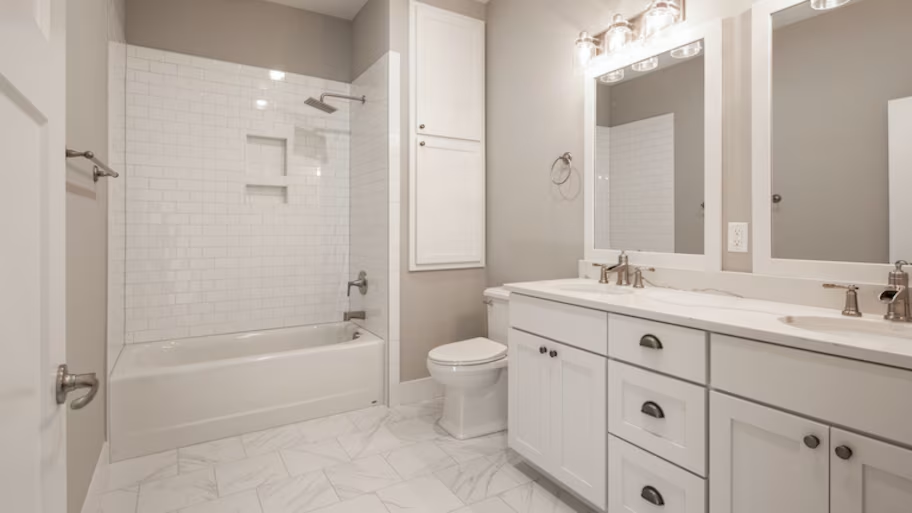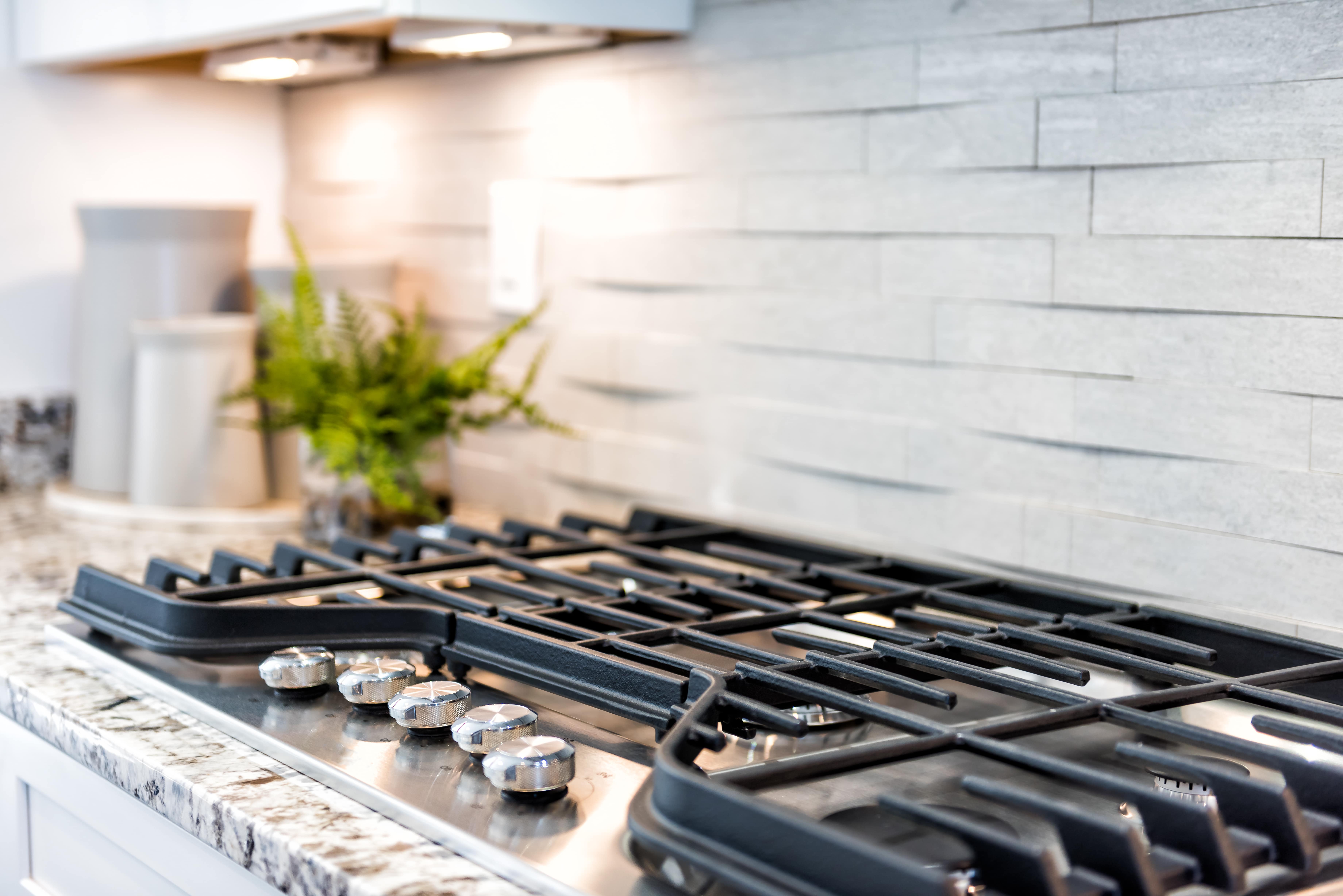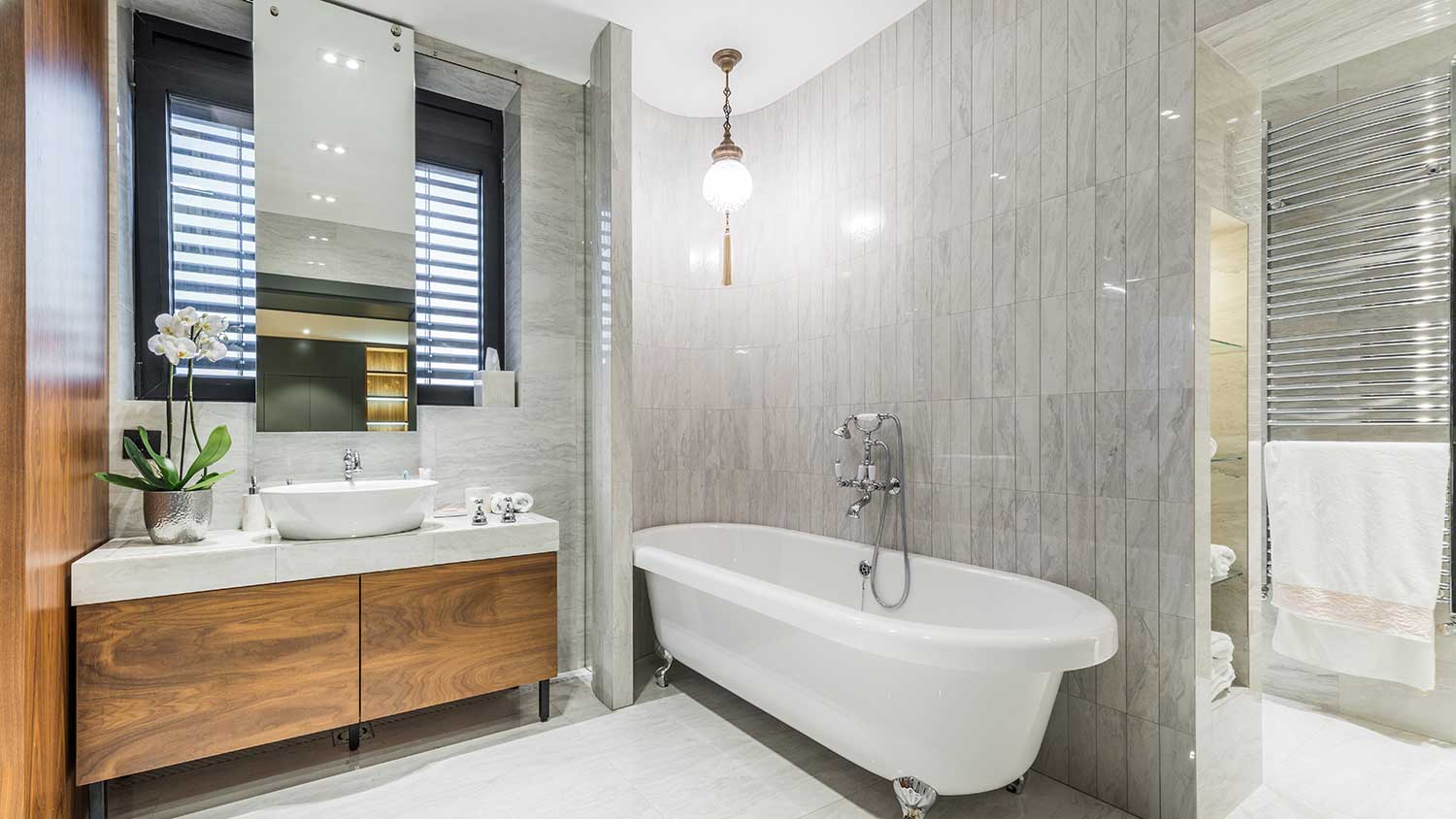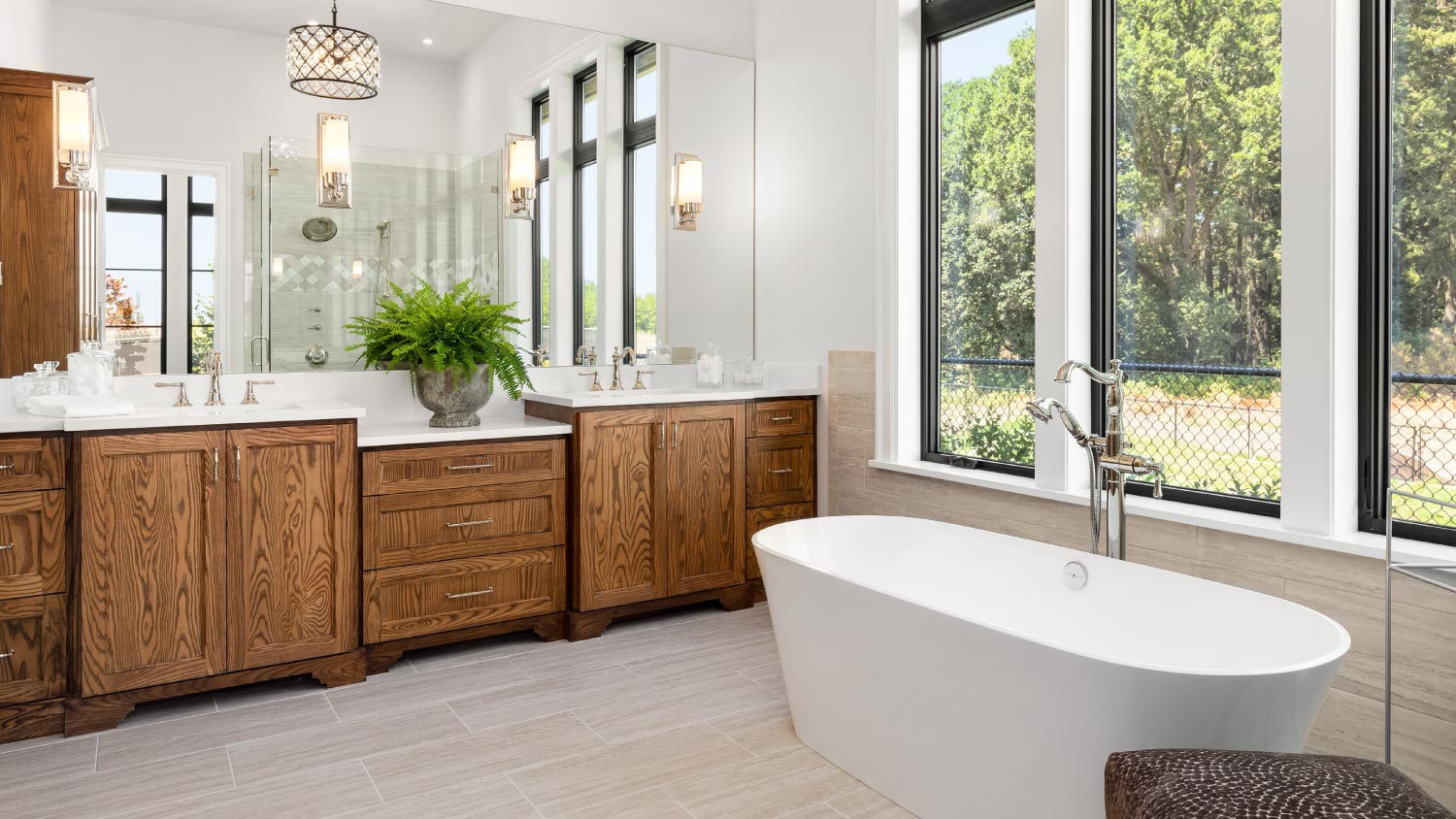
Curious how much a shower remodel costs? From new fixtures to full installations, we have the prices you need to know to establish a shower remodel budget.
Backsplash installation costs range from $480 to $1,500, with an average price of $1,000 depending on the materials used and the backsplash size. A pro can give you more detailed pricing information based on what you have in mind.


Installing a backsplash costs between $15 and $40 per square foot.
Your total cost will depend on the size of your space and the backsplash material.
Labor rates in your area will also influence the cost of backsplash installation.
Some of the most affordable backsplash options include brick, tin, and ceramic.
For a higher-end material like marble, you could spend up to $150 per square foot.
The average backsplash installation cost is $1,000, with prices ranging from $480 to $1,500, based on 35 square feet of backsplash. You could pay as much as $4,500 for a high-end material like a marble backsplash or as little as $300 for more affordable materials like brick. Most backsplash projects cost $15 to $40 per square foot.
A bright white subway tile or a stamped tin backsplash can brighten your kitchen. Here are the cost factors to include in your backsplash budget.
Graph: See the price range for backsplash installation:
| Square Feet | Average Installation Cost (Including Labor) | Installation Cost Range (Including Labor) |
|---|---|---|
| 15 | $420 | $225–$600 |
| 20 | $560 | $280–$800 |
| 25 | $700 | $350–$1,000 |
| 30 | $840 | $450–$1,200 |
| 40 | $1,120 | $600–$1,600 |
| 50 | $1,400 | $750–$2,000 |
Backsplash installation costs an average of $15 to $40 per square foot. Expect to pay more for a pro to cut tiles around your kitchen's outlets, switches, windows, and other odd shapes. The range your project falls in depends mainly on the cost of materials.

The material you choose will also affect your backsplash installation cost. Different materials have varying costs per square foot, ranging from $10 for tin or brick to $150 for marble. The material can also affect labor costs, as cutting marble takes more time and precision than tin or wooden beadboard.
| Backsplash Material | Average Price per Square Foot (Including Labor) |
|---|---|
| Beadboard | $18–$26 |
| Brick | $10–$40 |
| Ceramic | $12–$32 |
| Glass | $18–$42 |
| Granite | $20–$46 |
| Marble | $30–$150 |
| Natural stone | $20–$68 |
| Porcelain | $14–$28 |
| Slate | $18–$42 |
| Stainless steel | $25–$75 |
| Tin | $10–$30 |
| Travertine | $16–$25 |
Don’t forget to consider which type of backsplash material and texture will be easiest to clean. The simplest materials to clean are tile, glass, stainless steel, and ceramic.
The backsplash material you choose will be the most significant cost factor, but you’ll need to budget between $5 and $20 per square foot for backsplash installation labor. The cost is lower if you have a simple, rectangular section to cover with few outlets, windows, and cabinets to cut around.
Most contractors charge by square footage based on the project complexity and material, but some charge per hour for labor. If you want to install a complex design or pattern, like herringbone, a pro will charge around $100 per hour for labor instead of $40 to $60 per hour for simpler patterns and materials. The larger your backsplash, the more you’ll pay for labor.
It also helps to choose a material that’s easier to cut and less likely to break, as this will reduce the time it takes your pro to get the job done. Hiring a local backsplash installation company is your best option for two reasons. First, you’ll get a professional appearance in one of your home's more frequented rooms. Second, a pro can help you decide which material best suits your budget, lifestyle, and decor.
| Labor Rate | Average Cost |
|---|---|
| Per square foot | $5–$20 |
| Hourly | $50–$100 |
There are other minor cost factors you might need to consider to get the most accurate price possible for your backsplash project.
If you prefer a mosaic look or a herringbone pattern, contractors will charge closer to $100 per hour or up to $500 per day for the installation. Your backsplash pro will also account for how many obstructions they need to cut around on the wall. For example, if you have multiple outlets or switches, cabinets, or windows that cut into the backsplash, it will take your pro longer to make precise cuts.
You have three options for the material your professional installs on your backsplash:
Individual tiles: This option takes the longest to install because your pro has to set each tile. However, they allow for total customization, so your backsplash ideas and imagination are the only limitations.
Slabs: Like marble or granite, slabs are precut to cover your entire backsplash. Precise measurements are needed for cutting before delivery. However, the labor is less costly since the entire backsplash goes up in a single piece, but the higher material cost means you’ll spend more overall.
Tile sheets: These are prearranged tiles on a mesh backing that allows your pro to install an entire square foot of individual tiles at once. This cuts down on labor costs when working with small tiles. The only downside is that you’re limited to the available designs and patterns.
Backsplash installation costs can vary based on where you’re doing the work. Replacing your backsplash will be more expensive in the kitchen because the countertops are longer than those in bathrooms.
Bathroom backsplashes require cement backer board due to the higher risk of water and humidity getting behind the tiles. Backer board is more expensive than drywall, so bathrooms can be more expensive per square foot. Overall, replacing a kitchen backsplash usually costs more than replacing one in a bathroom.
Professional backsplash removal costs between $3 and $6 per square foot, including disposal. You might have to replace the drywall or backer board underneath the old tile. If you remove the backsplash yourself, you’ll need a chisel and a hammer. You’ll need to patch the drywall and ensure the surface is smooth and dry before installing a new tile backsplash.
Backsplash installation may appear simple on the surface, but several factors can make it more complicated than it seems. Certain tile materials, such as marble and ceramic, are difficult to cut and require specialized tools that professionals will bring to the project. Even slabs require precise measurements to fit properly. Hiring a local backsplash installation pro is the best choice to get the project done right.
Professional backsplash installation experts will bring their specialized knowledge and experience to the project, including:
Your pro will have special tools and equipment to cut backsplash materials.
They will measure properly for tiles and slabs to reduce material waste and ensure there’s enough to complete the project.
An installer can remove the existing backsplash and dispose of the old materials.
Pros can make necessary repairs after the existing backsplash is removed.
They can handle complex backsplash installation patterns that a DIYer may struggle with.
DIY backsplash installation can result in wasted materials and installation errors, but if you want to make the task easier for the pro, here are a few things you can do:
Clear counters and the surrounding area to make space for tools and installation materials
Remove the existing backsplash
Remove outlet covers
Clean the installation area, so the surface is ready for the new backsplash
Pick up the tiles and other materials prior to the installation
Peel-and-stick tile can be a good short-term solution for a pop of color in other places in your home, but avoid using it in your bathrooms. The high mositure level can create issues with the tile sticking and looking its best for a long period of time.

Installing a backsplash can add instant elegance and charm to your kitchen, but it comes at a cost. Luckily, there are ways to save on your kitchen backsplash installation project, including the following:
Pick up the tiles yourself instead of paying shipping fees
Check home improvement stores for sales
Opt for prearranged tile sheets over tiles or slabs
Choose larger tiles that are less time-intensive to install
Learn how to install a peel-and-stick backsplash
Choose a cost-effective backsplash material like tin
Retile a focal point in your kitchen, such as above the stove, instead of the entire kitchen
Install a kitchen backsplash at the same time as another kitchen project—such as countertop installation—to save on labor and trip fees
In some cases, installing a backsplash will increase your home value, but it depends on a few factors. First, if you’re replacing an existing backsplash that’s in decent shape with a new one to suit your tastes, you might not be adding any value, especially if the new backsplash isn’t generally desirable. Second, the backsplash material you choose and its longevity can determine your return on investment.
Certain renovations, like a total kitchen remodel, increase home value hands down. However, a backsplash is a feature that appeals to some and not to others. If you’re selling your house, a new backsplash may raise the value indirectly if it’s a desirable design choice for a particular buyer, while it might have the opposite effect on others.
Discuss materials, such as wallet-friendly porcelain or high-end marble, that fit within your budget.
Know exactly where you want your backsplash so your pro can take precise measurements.
Share your ideas and vision, so the backsplash installer knows the look and feel you want to achieve.
Ask if there are tasks you can complete before the backsplash pro arrives, such as clearing the area.
Home is the most important place on earth, which is why Angi has helped more than 150 million homeowners transform their houses into homes they adore. To help homeowners with their next project, Angi provides readers with the most accurate cost data and upholds strict editorial standards. We extensively research project costs to develop the pricing data you see, so you can make the best decisions for you and your home. We rely on reputable sources, including the U.S. Bureau of Labor Statistics, academic journals, market studies, and interviews with industry experts—all to ensure our prices reflect real-world projects.
Want to help us improve our cost data? Send us a recent project quote to [email protected]. Quotes and personal information will not be shared publicly.
From average costs to expert advice, get all the answers you need to get your job done.

Curious how much a shower remodel costs? From new fixtures to full installations, we have the prices you need to know to establish a shower remodel budget.

Finishing an attic can make a great addition to your home. This guide breaks down the cost to finish an attic, including labor, materials, and more.

Small kitchen remodels cost $12,750 on average, depending on the materials, size, labor, and more. Read this to calculate your kitchen remodel costs.

An updated bathtub can give a bathroom a whole new look. Find out how much it costs to replace a bathtub in Houston, TX, including prices by type and labor costs.

Discover how to dispose of old countertops, including removing, recycling, and donating. Our expert guide has all the info for DIYing or hiring a pro.

An updated bathtub can give a bathroom a whole new look. Find out how much it costs to replace a bathtub in Tampa, FL, including prices by type and labor costs.